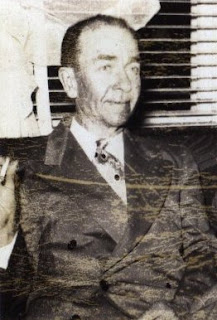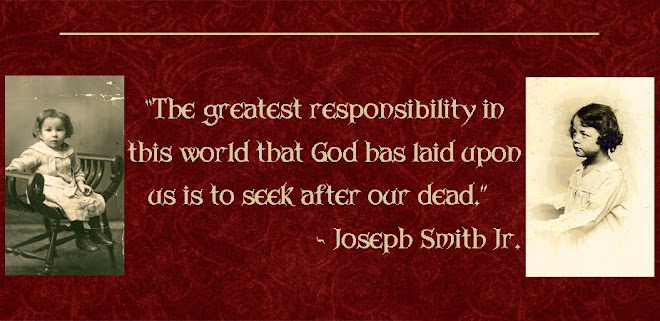The other day my Grandma Bev called and asked me a question about a genealogy website, and she mentioned my 4th great grandfather, William Vincent. A few days later I was still thinking about William Vincent, so I decided to see what I could find out. I looked back at my censes chart that I had made for William Vincent and his wife, Mary Elizabeth Vance and their children, and found that last time I had done any research on the family I had only been able to find info about William Vincent after he was married, and I didn’t know anything about his parents or ancestors. The only thing I knew about his family was that he had a brother, John Vincent, who was living next door to him on the 1860 census.
So, I started trying to find out more about William Vincent on a census earlier than 1860 (the first census after his 1851 marriage). After some searching, I came across an 1850 census in Nodaway, Andrew county, Missouri with the family of Irvin and Ann Eliza Goff and their four young children. Living with that family was 21 year old William Vincent, 19 year old John Vincent, and 13 year old Nancy E. Vincent. William and John were both born in Kentucky – their birth dates and locations were consistent with the information that I had about William and his brother. And Nancy was born in Missouri. Interestingly, all three of the Vincent siblings were listed with a $200 real estate value – this made me curious if their parents had recently passed away and willed them each equal amounts of their land/house – because you don’t usually find a 13 year old girl with real estate value.  |
| A chart of census records that I've found for the William and Mary Vincent family so far. |
So, here is a pedigree chart showing the little I knew about William Vincent before this week:
And here’s the pedigree chart with some of the new info about William’s ancestors:
And these photos were included with that family tree that was submitted to ancestry.com – they are of William Vincent’s sister, Rufina Vincent and her husband, James Anderson Warhurst. (If I can’t find a photo of my ancestor, it’s pretty cool to find a photo of his sister at least).
Rufina Vincent Warhurst and James Anderson Warhurst
This is the story that I mentioned about Rufina Vincent and her husband. Pretty interesting, I thought. William Vincent and his family lived in Brown County, Kansas at one point too, before moving back to Missouri later on – I wonder if they had a similar situation and if they lived nearby and interacted with Rufina and her family?
http://www.ancestry.com/, ancestry.com user, “tdrolsum” originally submitted this to “Tammy D.'s Family Tree” on 21 Jun 2008.
“The Warhursts Go West, c. 1850 , Missouri and Kansas
Contributed by Virginia Warhurst, 1631 Ardath, Wichita Falls Texas 76301, 25 March 1974, from information collected by Harry Warhurst; sent to Patricia Johnsen Hicks, Weaverville, California.
retyped by Pat Hicks July 8, 2001
JAMES ANDERSON WARHURST and RUFINA VINCENT
"Many, many years ago, dark haired Rufina Vincent, a girl of 14, and James A. Warhurst, a stalwart youth of 21 summers, were married in a little church in Missouri. After a few short, happy years of life in Missouri, during which chubby Gus and tiny Bell were born to them, they decided to move to the territory of Kansas.
"Having sold their property and collected their possessions, they bought an unblemished team of young horses, a new wagon and harness, and clothing and cloth enough to clothe them for a year. They also bought a year's supply of flour, meat, sugar, coffee, and other provisions. They stored their supplies in their home.
"The evening before the day they planned to start was rather sad, for it was not easy for such young people as Rufina and Jim to say good-bye to their relatives and friends and go to live in such a lonely, uninhabited place.
On returning home this particular evening, they backed the wagon up to the door and put the harness under the wagon in order that they might be ready to load early the next morning. After turning the horses in their pen, they retired for the night.
"During the night they were awakened by fire falling in their faces. They snatched up the children and barely escaped with their lives. Their only belongings which were not destroyed by fire were their night clothes and their horses, as the crumbling house fell on the wagon and destroyed both it and their harness.
"Undaunted by such a hard blow, they sold their horses, bought a yoke of oxen, a wagon, and what supplies they could, and started on their journey to Kansas. They crossed the Missouri river at Iowa Point into Kansas, and began looking for a favorable location. They arrived in Kansas two years before it was open for settlement.
"They drove in a northwest direction across what was later Doniphan County, Kansas, and into what is Brown County, Irving township, and settled at a place. When it was surveyed, several years later, it proved to be the southwest quarter of section 21, township 1, range 18, east.
How did they happen to stop at this particular spot?
They were driving along the divide one day, hot, thirsty, and tired. The children were exceptionally cross and the oxen in great need of water. Suddenly the oxen smelled the water in the creek north of them, which was later called Cottonwood Creek, and in the creek which they were approaching, known as Roy's creek. Suddenly they (the oxen) took the matter of location into their own hands, and turned north, left the trail, and ran away, making for water. Jim ran beside the frenzied animals, whipping them over the head, but to no avail. After he had become winded, he jumped back into the wagon, and shortly after, the oxen plunged over a high bank into Roy's Creek, the water of which came into the wagon box.
"Rufina carried the children to the north side of the creek, climbed the steep bank, and said smilingly as she stood wringing the water from her skirts, "Now, Jim, that's a pretty mess," at which he smiled grimly. After she had the children as dry as possible, and he had led the oxen (now quite tame) out and tied them to a tree, they realized that all their earthly possessions were soaking in creek water. So, with no great amount of clothing, they proceeded to carry their goods and trappings out and spread them on the bank to dry.
"While Jim was occupied with the oxen, hauling the wagon out a piece at a time, Rufina took the babies and walked west, perhaps a hundred yards. She noticed water seeping out of a bank, and, with the aid of a stick, she soon had a nice little spring running and had it dug out enough so that one could dip water from it with a cup. Very enthusiastically, she ran to where Jim was and told him she had found water - a good place to camp. They later moved their belongings to the spring and camped.
"There was an abundance of grass near the creek, and on a flat west of the spring, the grass was higher than the oxen's backs. They decided that since nobody seemed to be near to have a claim, this was the very spot upon which to build their home. So they cut logs and dragged them across the creek and built a house near the spring. They laid claim to the creek bottom, staked out their claim, cleared the brush from a bend in the creek and plowed it, ready to plant a crop in the following spring.
"Spring came at last and Jim planted every kind of seed which he had brought from their home in Missouri: including corn, potatoes, squash, pumpkins, turnips, beans, etc. The year proved to be a very favorable one. Although they had more corn than they needed and all the hay they could cut with a scythe, and an abundance of everything, they could not sell a wagon load of their produce for 50 cents, because the only people near them were Indians who were always hungry, but never had any money to buy with.
"Rufina and Jim could not turn the Indians away, as they were in reality trespassers on Indian lands, and so they had to endure a great deal. While they had plenty to eat, they had no neighbors, no money, and could not sell anything they had. Consequently, they made trips to Missouri to work to get provisions and clothing. Later, they purchased a flock of sheep, and Rufina helped shear them. She then scoured, carded, spul and wove the wool into cloth from which she made the clothing for the family.
"In later years when the country was open to settlement and surveyed, the Warhurst place proved to be mostly rolling plains instead of bottom land as they had hoped. Their house was only 50 yards from the Brown county line. Shortly after their land was surveyed, their house burned and they built another higher up on the hill. They had lived on this place for over 35 years when Rufina died at the age of 50 years. Jim, broken hearted, sold the place and went to Oklahoma where he spent the rest of his life with his devoted daughter, Bell. Both Rufina and Jim were buried one-half mile from the place where their first house stood."






.jpg)


.jpg)
.jpg)

.jpg)
.jpg)
.jpg)
.jpg)
.jpg)
.jpg)
.jpg)
.jpg)
